| Type | Public |
|---|---|
| Industry | Clothing manufacture |
| Founded | Wellington, New Zealand 1995 |
| Headquarters | , |
Key people | Jeremy Moon - Founder Jan Van Mossevelde - CEO |
| Products | Base layers, Tops, T-shirts, Sweaters, Knitwear, Hoodies, Jackets, Socks, Underwear, Accessories |
Number of employees | 400 (globally) |
| Website | www |
Icebreaker is a merino wool outdoor and natural performance outdoor clothing brand headquartered in Auckland, New Zealand. It was purchased by VF Corporation, a NYSE listed entity in 2018. Icebreaker was conceived and designed around the philosophy of sustainability, using natural fibres, environmental and social ethics, and animal welfare. The company began by specialising in the creation of merino base layers and now offers underwear, mid layers, outer wear, socks and accessories based on natural fibers.
Icebreaker was founded in 1995 by Jeremy Moon, and now supplies its clothing to more than 4,700 stores in 50 countries. [1]
Icebreaker started when, in 1994, an American girlfriend introduced Jeremy Moon, then 24, to a merino wool farmer she had stayed with as she backpacked around New Zealand. Brian and Fiona Brakenridge [2] lived on the remote Pohuenui Island in Marlborough with their two sons Ben and Sam and 5,000 sheep. They had developed some prototype thermal underwear made from 100% pure New Zealand merino wool, a fibre that was then of such little value that it was sold at low cost to be blended with traditional wool. [3]
Icebreaker began selling its products in New Zealand, followed by Australia. The company has been growing in Europe and acquiring its distributors there. [4] In 2010, one in every three Icebreaker garments was sold in Europe, now one of Icebreaker's largest markets. In 2010 company sales were approximately $100 million. [3] In 2014 company sales were approximately $200 million. [5]
The company's first United States headquarters were in Santa Barbara, California and then in Sun Valley, Idaho. [3] It moved offices to Portland, Oregon [6] in 2007 and, in December 2008 combined its U.S. sales and marketing office with its global design studio at a new headquarters at 1330 NW 14th Avenue in Portland, which was Gold certified by the Leadership in Energy and Environmental Design (LEED) green building rating system established by the U.S. Green Building Council. [7]
Icebreaker sells through wholesale channels, retail stores, and its website. It opened its first retail store at the Wellington International Airport in 2005. In 2007, Icebreaker opened its first overseas TouchLab retail stores in Montreal, Quebec, Canada, and Portland, Oregon, USA. In 2010, Icebreaker opened its first store in Auckland and its first independent store in Europe, in collaboration with Travel Store SARL as retail partner, at 21st Avenue Michel Croz, Chamonix, Mont-Blanc, France. [8] The company opened its first store in the SoHo neighborhood of New York City in November 2010, [9] to be followed by continued retail expansion. [1]
Icebreaker has been the subject of two case studies by Harvard Business School. [10] In 2009, The New Zealand Herald named Icebreaker's Moon one of the country's top business leaders. [11]
Icebreaker has moved its manufacturing from New Zealand to China. [12] It commenced trials to move production to China in 2003 and delivered first product from offshore manufacture in early 2004. Icebreaker then used a phased approach over the following 2–3 years to ensure impact on NZ manufacturing was minimal. Socks are all manufactured in the USA.[ citation needed ]
After having been on the company's board since July 2012, [13] former Air New Zealand CEO Rob Fyfe started as its executive chairman in September 2013. [14]
VF agreed to purchase Icebreaker in 2017. [15]
In November 2017, Icebreaker signed a $100 million supply contract with New Zealand merino farmers. [16]
Icebreaker has developed a merino fibre layering system in multiple weights including: 120 g/m2 Featherweight, 150 g/m2 Ultralite, 200 g/m2 Lightweight, 260 g/m2 Midweight, 320 g/m2 Midlayer and 380 g/m2 Outerlayer. Icebreaker products can be worn solo or layered. Collections include Superfine Lightweight Travel for warm to hot conditions and all season wear; City Lightweight Urban Wear; Icebreaker GT stand alone and insulation layers for active sports such as skiing and snowboarding; Icebreaker GT Running, Road Cycling and Mountain biking lines with Lycra; Bodyfit Active Base Layers for outdoor sports; wind resistant Outer Layers; and underwear for men and women. The company also makes socks and accessories including headwear, gloves and neckwear. It also has a kids collection. [17] In the Autumn of 2010, Icebreaker introduced Realfleece, which unlike synthetic fleece, is made of merino. [3]
Icebreaker was conceived and designed around the philosophy of sustainability, using natural fibres, environmental and social ethics, and animal welfare.
In August 2008 it launched Icebreaker Baacode, [18] a system that allowed consumers to trace the origins of their Icebreaker right to a sheep station (sheep farm) in the Southern Alps of New Zealand, where the merino fibre was grown. Icebreaker merino fabric is certified to Oeko-tex standard 100 Class 1 and Icebreaker factories meet ISO 14001 environmental standards[ citation needed ].
Icebreaker pioneered long-term contracts that pay a significant price premium to selected New Zealand sheep farmers and allow them to carry out long-term planning. [3] In return, contracted growers agree to meet Icebreaker's strict conditions on environmental and social issues, and on animal welfare. Icebreaker is now supplied with merino fibre by 140 high country stations, which cover more than 2 million acres (810,000ha) of New Zealand countryside. In June 2008, Icebreaker signed the biggest wool contract ever in New Zealand, worth approximately US$50 million[ citation needed ].
The company prohibits the practice of mulesing [ citation needed ], which includes the traditional surgical method and the clips method. Mulesing removes strips of skin around the tail to prevent the fly-strike disease, Myiasis. In order to avoid mulesing, sheep that produce Icebreaker merino may be treated through medicines and chemicals for the disease.

Wool is the textile fibre obtained from sheep and other mammals, especially goats, rabbits, and camelids. The term may also refer to inorganic materials, such as mineral wool and glass wool, that have properties similar to animal wool.

Yarn is a long continuous length of interlocked fibres, used in sewing, crocheting, knitting, weaving, embroidery, ropemaking, and the production of textiles. Thread is a type of yarn intended for sewing by hand or machine. Modern manufactured sewing threads may be finished with wax or other lubricants to withstand the stresses involved in sewing. Embroidery threads are yarns specifically designed for needlework. Yarn can be made of a number of natural or synthetic materials, and comes in a variety of colors and thicknesses. Although yarn may be dyed different colours, most yarns are solid coloured with a uniform hue.

The Merino is a breed or group of breeds of domestic sheep, characterised by very fine soft wool. It was established in Spain near the end of the Middle Ages, and was for several centuries kept as a strict Spanish monopoly; exports of the breed were not allowed, and those who tried risked the death penalty. During the eighteenth century, flocks were sent to the courts of a number of European countries, including France, Hungary, the Netherlands, Prussia, Saxony and Sweden. The Merino subsequently spread to many parts of the world, including South Africa, Australia, and New Zealand. Numerous recognised breeds, strains and variants have developed from the original type; these include, among others, the American Merino and Delaine Merino in the Americas, the Australian Merino, Booroola Merino and Peppin Merino in Oceania, and the Gentile di Puglia, Merinolandschaf and Rambouillet in Europe.
Long underwear, also called long johns or thermal underwear, is a style of two-piece underwear with long legs and long sleeves that is normally worn during cold weather. It is commonly worn by people under their clothes in cold countries.

Sheep farming or sheep husbandry is the raising and breeding of domestic sheep. It is a branch of animal husbandry. Sheep are raised principally for their meat, milk, and fiber (wool). They also yield sheepskin and parchment.
Polwarth is a breed of sheep that was developed in Victoria (Australia) during 1880. They were of one-quarter Lincoln and three-quarters Merino bloodlines. They are large, predominantly polled sheep with long, soft, quite fine wool and produce good meat carcasses. They were developed in an attempt to extend the grazing territory of sheep because the Merino was found lacking in hardiness in this respect. A dual-purpose breed with a major emphasis on wool production. Richard Dennis, of Tarndwarncoort in south west Victoria, bred the Polwarth, first known as Dennis Comebacks. Descendants of Richards Dennis continue to grow Polwarth wool at Tarndwarncoort, maintaining the original bloodlines in a flock referred to as the "Blue Dots".
Mulesing is the removal of strips of wool-bearing skin from around the breech (buttocks) of a sheep to prevent the parasitic infection flystrike (myiasis). The wool around the buttocks can retain feces and urine, which attracts flies. The scar tissue that grows over the wound does not grow wool, so is less likely to attract the flies that cause flystrike. Mulesing is a common practice in Australia for this purpose, particularly on highly wrinkled Merino sheep. Mulesing is considered by some to be a skilled surgical task. Mulesing can only affect flystrike on the area cut out and has no effect on flystrike on any other part of the animal's body.
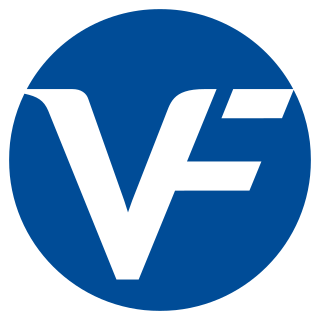
VF Corporation is an American global apparel and footwear company founded in 1899 by John Barbey and headquartered in Denver, Colorado. The company's 13 brands are organized into three categories: Outdoor, Active and Work. The company controls 55% of the U.S. backpack market with the JanSport, Eastpak, Timberland, and The North Face brands.

A wool bale is a standard sized and weighted pack of classed wool compressed by the mechanical means of a wool press. This is the regulation required method of packaging for wool, to keep it uncontaminated and readily identifiable. A "bale of wool" is also the standard trading unit for wool on the wholesale national and international markets.

Camel hair specifically refers to the fur from the body of a camel, but more generally refers to the fibre that may be made from either pure camel hair or a blend of camel hair and another fibre.
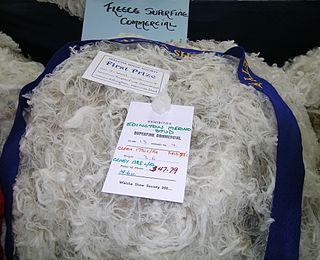
A micron (micrometre) is the measurement used to express the diameter of wool fibre. Fine wool fibers have a low micron value. Fibre diameter is the most important characteristic of wool in determining its value.

Smartwool is an American clothing company. It was founded in 1994 in Steamboat Springs, Colorado by ski instructors Peter and Patty Duke. In 2005 The Timberland Company acquired Smartwool and in 2011 Smartwool became a subsidiary of VF Corporation upon VF Corporation's acquisition of The Timberland Company.
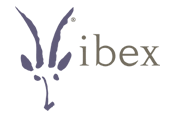
Ibex Outdoor Clothing, LLC is a producer of wool clothing designed for outdoor use sold through a website and retailers. For the year 2001 Ibex made US$1.5 million in sales, and by 2012 had reached US$12 million in sales. Between 2014 and 2017 sales averaged US$20 Million.

The raising of domestic sheep has occurred in nearly every inhabited part of the globe, and the variations in cultures and languages which have kept sheep has produced a vast lexicon of unique terminology used to describe sheep husbandry.

The history of the domestic sheep goes back to between 11,000 and 9,000 BC, and the domestication of the wild mouflon in ancient Mesopotamia. Sheep are among the first animals to have been domesticated by humans. These sheep were primarily raised for meat, milk, and skins. Woolly sheep began to be developed around 6000 BC. They were then imported to Africa and Europe via trading.
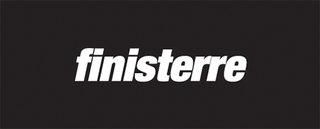
Finisterre is an outdoor apparel company with a focus on functional and sustainable products. Based in St Agnes, Cornwall, and founded by Tom Kay in 2003 they are recognised as a cold water surf company.
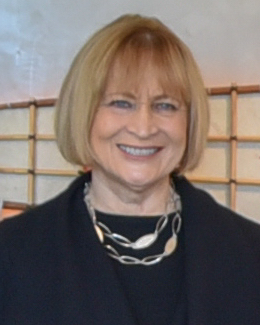
Perilyn Drysdale is a New Zealand entrepreneur and business owner. She is the founder and CEO of the fashion companies "Snowy Peak" and "Untouched World", which produce ecologically sustainable clothing, and the founder of the Untouched World Foundation, which runs programmes in sustainable leadership.
Jeremy Moon is a New Zealand businessman and entrepreneur who founded the clothing manufacturer Icebreaker in 1995. Moon used $25,000 to found the business, making garments from New Zealand merino wool.
Barkers or Barkers Men's Clothing is a New Zealand menswear fashion brand and retail chain. It has 31 stores around the country, including 13 in Auckland. It was established in Auckland CBD in 1972, and is headquartered in Grafton, Auckland. The chain sells a range of men's clothing, including shirts, knitwear, pants, jeans, sweatshirts, jackets and coats, blazers, t-shirts, shorts, polo shirts, socks, ties and belts.
Accent Group is an Australian and New Zealand footwear and clothing retail, wholesaling and distribution company. It has more than 700 retail stores, along with 19 brands, and more than 20 online platforms.